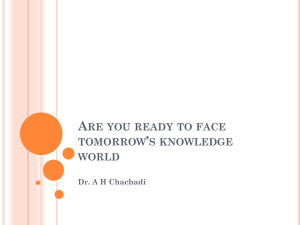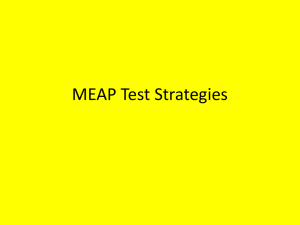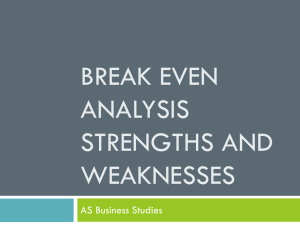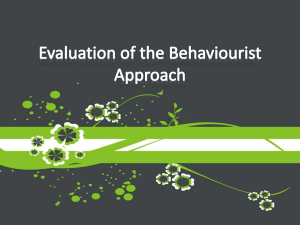Exceptional Leadership
advertisement
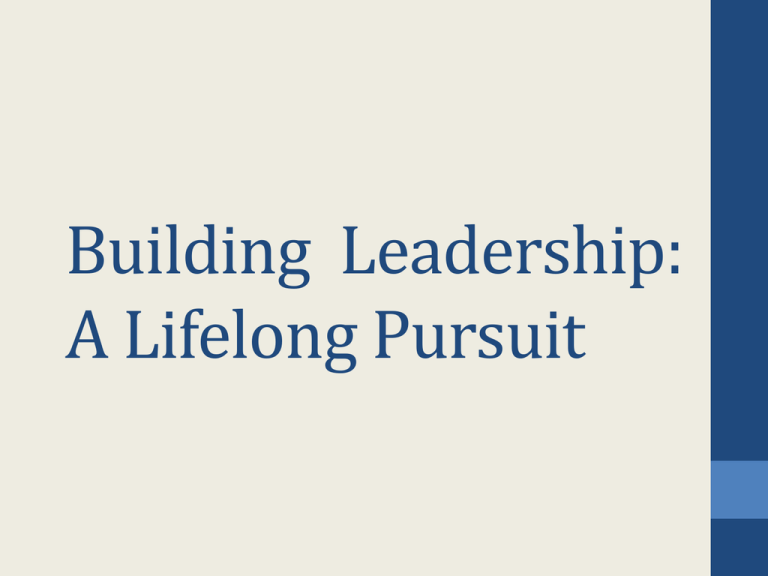
Building Leadership: A Lifelong Pursuit Goal: To encourage you to build your full leadership potential • To recognize and learn from leaders • To know leadership characteristics and build these ‘habits’ • To identify your strengths and sustain their development Leaders vs. Managers • Leaders visionaries, strategic thinkers, influential, decisive, goal directed, a sense of mission • Managers focus on the task at hand, establishing clear, transparent finances, obtain the best possible outcomes with limited resources • You manage things; you lead people. • Some do both well; both are essential but skills sets differ Leadership development • Social and psychological scienceobservational studies, surveys • Essential for corporate, organizational, and government success • 91,000 books on leadership • Still many unknowns • Zenger, Rath, Covey, WHO my primary sources Leadership Roles • • • • • • • • • • Patient care/public health Research Administration Education Family/home Business Government/politics Community Civil society/boards Do leadership skills in the workplace work the same way at home? Great Leaders • Are magnets for highly committed individuals ( >70% of employees positive about leader/boss, workplace) • Discover and grow the strengths of others • Are trust worthy • Stay and build-have a long term focus • Demonstrate gratitude and appreciation • Not risk averse • Are loyal • But not perfect Seven Characteristics (Covey) • Continually learning, training, asking questions, developing new skills • Daily putting on the ‘harness of service’ • Radiate positive energy, upbeat, enthusiastic • Believe in others • Lead balanced lives • See life as an adventure • Change catalyst usually with synergistic solutions The Focus on Strengths & Weaknesses • Peter Drucker: Most individuals think they know what they are good at. They are usually wrong! • Since 1990 leadership gurus have agreedindividuals don’t identify strengths well • Need others (bosses, friends, clients) to inform us, possibly ‘strength finder assessment’ • Organizations need to assist individuals to identify and grow strengths • Stop addressing weaknesses (still common part of many performance reviews) Why focus on strengths? • Most leadership strengths can be improved-from 50-70% to 90-95% • Weaknesses (usually at <30% efficacy) usually are improved minimally and then return to baseline • Employee survey-42% provide no feedback; 56% on weaknesses; 2% on strengths 34 Strengths (Competencies) www.strengthsfinder.com • Achiever • Activator • Adaptability • Analytical • Arranger • Belief • Command • Communications • Competition • Connectedness • Consistency • Context • Deliberative • Developer • Discipline • Empathy • Focus • Futuristic Continuing Themes/Ideas • Harmony • Ideation • Includer • Individualization • Input • Intellection • Learner • Maximizer • Positivity • Realtor • Responsibility • Restorative • Self-assurance • Significance • Strategic • Woo My Five ‘Strengths’ • Learner- energized by the process. A catalyst for change. Need to be on the cutting edge. • Analytical- theories must be sound. Prove it or I won’t accept your observation. • Input-inquisitive, gathering ideas, fact repository • Arranger-’conductor’, enjoy complex challenges • Intellection-enjoy thinking, problem solving, musing, reflecting Fatal Flaws • As many as 20% of leaders have a ‘fatal flaw’ that can hinder or destroy leadership • Needs to be identified and addressed and may require professional help • Eg. uncontrollable anger; addictions; failing to complete tasks Conclusion Develop your potential to become an exceptional leader and use your strengths for a career that fulfills your dreams to make a difference The 360 Degree Assessment • Our self perceptions are often/usually wrong • Need accurate feedback processes from peers, boss, subordinates, customers, clients • Responses should take only 10-20 minutes and be annual • Positive process –identifying strengths, growing them, not harping on weaknesses Can you become the leader you want to be ? • Talents are inborn but need opportunity to be enhanced; leadership can be learned/acquireda lifelong goal • Potential varies- usually not well developed • Leadership is the right use of powers and principles • Power leadership- coercion. utility, or principles • Principled leadership-shared values, integrity, trust, ethical behavior, honour, respect, humility What about Weaknesses? • Disregard them unless a ‘fatal flaw’ is present • Possibly weaknesses need to be addressed in childhood to ensure adequate development across the knowledge spectrum • Organizations require a variety of leadersdifferent strengths are essential Sustaining Strengths • Sustainability = motivation x clarity x support from others (workplace) x opportunities for practice x measurement of progress • Motivation lies within the individual- drive, autonomy • Clarity-about the ‘strength’ and its application • Support-from the 360 • Practice-with input on performance • Metrics-identify targets, time frame Seven Deadly Leadership SinsGhandi • Wealth without work • Pleasure without conscience • Knowledge without character • Commerce without morality • Science without humanity • Religion without sacrifice • Politics without principles The Emergence of Servant Leadership • Arrogance/prominence was a valued component of leadership in Roman, Greek, even Jewish culture • Christian culture began emphasizing humility as a desired trait for success and effective leadership • Benjamin Israeli/Abe Lincoln- revered politicians both sought to lead with humility Quotes to quote (Forbes) • The function of a leader is to create more leaders, not more followers • You don’t need a title to be a leader. • People buy into the leader before they will buy the vision • Leadership is the art of getting someone else to do something you want done, because he wants to do it • Earn your leadership every day

